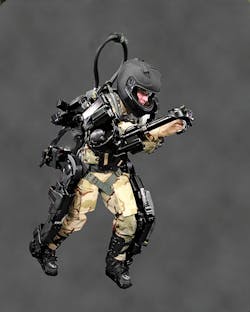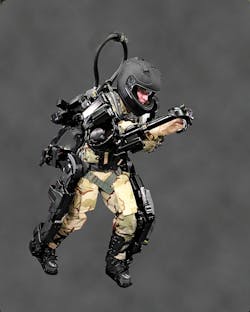Army asks industry for exoskeletons to help warfighters lift heavy loads
NATICK, Mass. — U.S. Army scientists are reaching out to industry for new ways to relieve infantry warfighters of heavy loads with load-bearing robotic suits called exoskeletons.
The U.S. Army is interested in a new generation of wearable robotics called exoskeletons to help warfighters lift heavy loads and fight at close quarters.
Army Contracting Command officials at Aberdeen Proving Ground, Md., have issued a sources-sought notice (01760-5011) called Request For Concept Papers On Exoskeleton Technologies For The Warfighter. The Army Contracting Command is issuing this industry call for papers on behalf of the Army Research, Development, and Engineering Command (RDECOM) Natick Soldier Research, Development, and Engineering Center (NSRDEC) in Natick, Mass.
The U.S. warfighter, whether on foot or in a vehicle, typically is physically overburdened, researchers point out. This increases fatigue, reduces movement and maneuver, and increases the likelihood of acute and chronic musculoskeletal injuries.
Exoskeletons are considered a promising approach to enable warfighters to maintain peak performance for longer than they can today. These exoskeletons are designed to improve strength, endurance, and ergonomics while maintaining user safety and reducing physical injury risk during various load tasks.
The Army is asking for industry white papers that outline innovative exoskeleton approaches to improve warfighter performance while they are moving over uneven terrain, performing ergonomically challenging load tasks for long periods in awkward postures, doing heavy lifting, or other repetitive lifting.
Effective exoskeleton systems demonstrate the principles of user safety, comfort, ease of use, integration with user clothing and individual mission equipment, energy efficiency to enable long operating durations, and low system costs.
Army experts expect they will need a variety of exoskeleton systems for infantry warfighters and logistics and mission support, for ergonomically challenging tasks, medium and heavy lift and carry, and specialized tasks like explosive ordnance disposal and chemical and biological protection.
Exoskeletons for infantry warfighters would facilitate running and walking for long periods, and help warfighters shoot, move, communicate, protect, and sustain. Logistics and mission support exoskeletons would focus on strength-enhancing or injury-reducing, low- or medium-mobility capabilities during lifting, loading, unloading, and transporting tasks. Light-task and medium-lift-and-carry exoskeletons would help warfighters with ergonomically challenging tasks, and make lifting tasks safer and more effective. Heavy-lift-and-carry exoskeletons would enable one person to perform load-handling tasks that one or more people normally handle. This could serve as a force multiplier, creating a smaller force with greater capabilities.
Specifically, Army researchers are looking for exoskeletons that could enable an infantry warfighter to march with loads of 99 to 136 pounds safely and without excessive exhaustion, and walk in a crouch, crawl, or jump obstacles while carrying loads of 75 to 90 pounds.
Exoskeletons should enable infantry warfighters to break down doors and fight at close quarters, load and unload cargo from vehicles, maintain land vehicles and aircraft, dig trenches, carry wounded comrades, and move hundred-pound obstructions to rescue others.
The Army would like to demonstrate some of these exoskeleton concepts as early as this summer. Companies interested should e-mail white papers to the Army’s Greg Kanagaki at [email protected]. For technical questions or concerns, contact the Army’s Kimberly Pumyea at [email protected] or 508-233-5167.
More information is online at https://www.fbo.gov/notices/9ba5618073c7bfa2d4abd42e1f5c4ee4.

